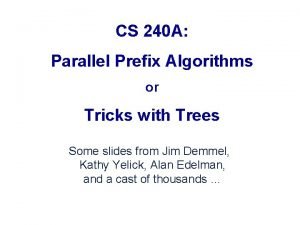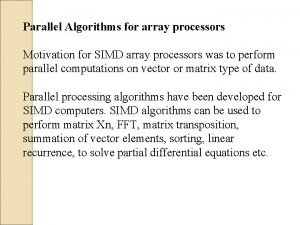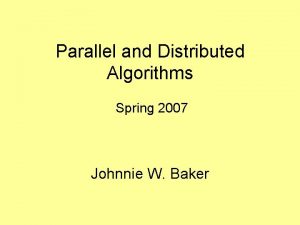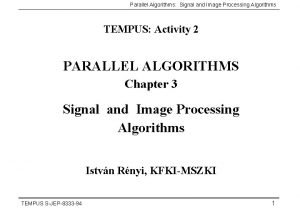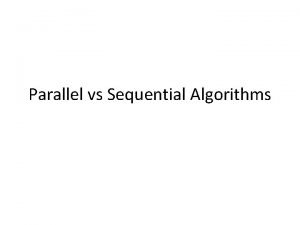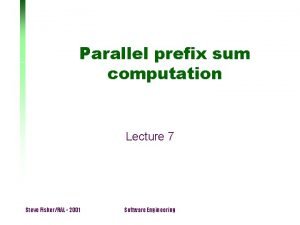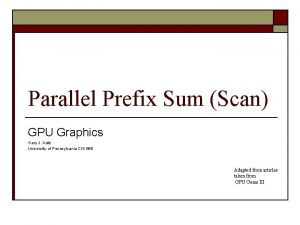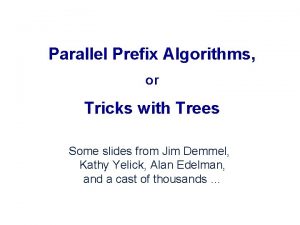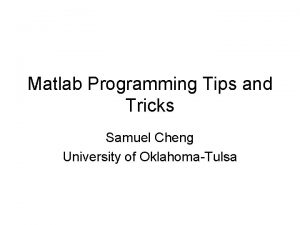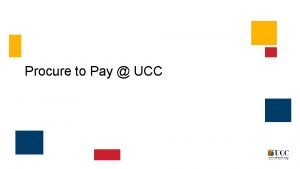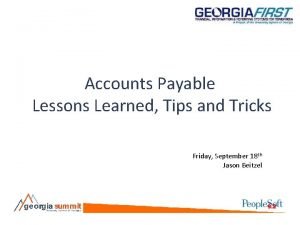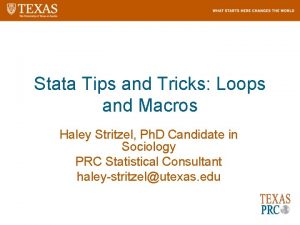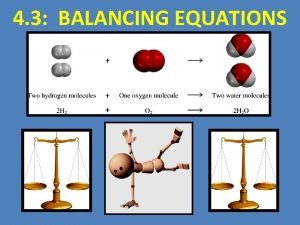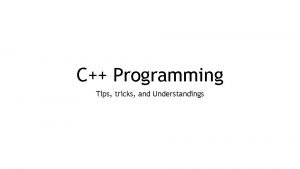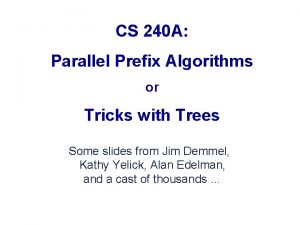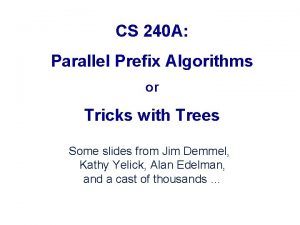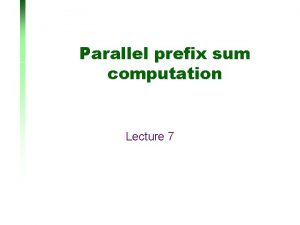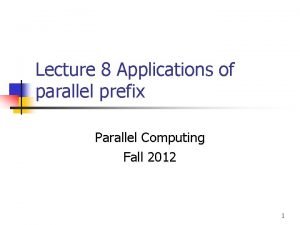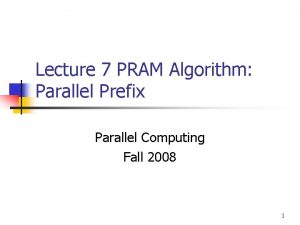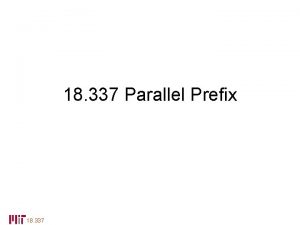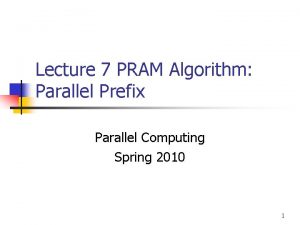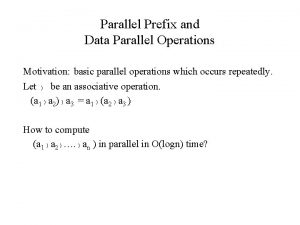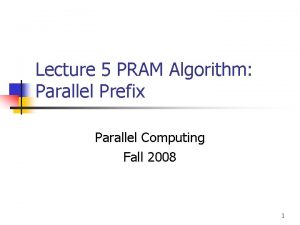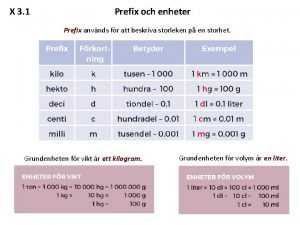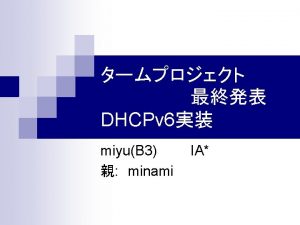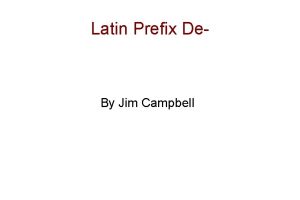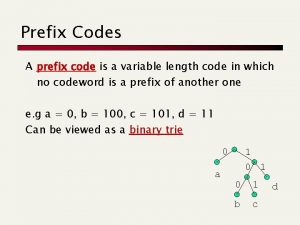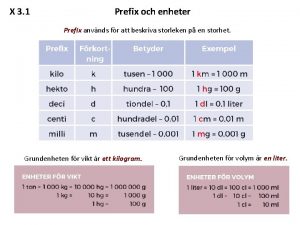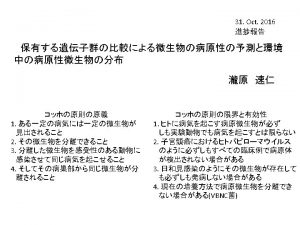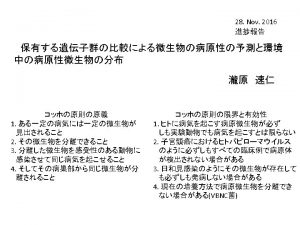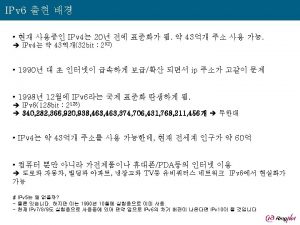CS 240 A Parallel Prefix Algorithms or Tricks






















![Adding two n-bit integers in O(log n) time • Let a = a[n-1]a[n-2]…a[0] and Adding two n-bit integers in O(log n) time • Let a = a[n-1]a[n-2]…a[0] and](https://slidetodoc.com/presentation_image_h/bb8319e45055dfc753abf91747638706/image-23.jpg)








- Slides: 31

CS 240 A: Parallel Prefix Algorithms or Tricks with Trees Some slides from Jim Demmel, Kathy Yelick, Alan Edelman, and a cast of thousands …

Parallel Vector Operations • Vector add: z = x + y • Embarrassingly parallel if vectors are aligned • DAXPY: z = a*x + y (a is scalar) • Broadcast a, followed by independent * and + • DDOT: s = x. Ty = Sj x[j] * y[j] • Independent * followed by + reduction

Broadcast and reduction • Broadcast of 1 value to p processors with log p span a Broadcast • Reduction of p values to 1 with log p span • Takes advantage of associativity in +, *, min, max, etc. 1 3 1 0 4 -6 3 2 Add-reduction 8

Parallel Prefix Algorithms • A theoretical secret for turning serial into parallel • Surprising parallel algorithms: If “there is no way to parallelize this algorithm!” … • … it’s probably a variation on parallel prefix!

Example of a prefix Sum Prefix Input Output x = (x 1, x 2, . . . , xn) y = (y 1, y 2, . . . , yn) yi = Σj=1: i xj Example x = ( 1, 2, 3, 4, 5, 6, 7, 8 ) y = ( 1, 3, 6, 10, 15, 21, 28, 36) Prefix Functions-- outputs depend upon an initial string

What do you think? • Can we really parallelize this? • It looks like this kind of code: y(0) = 0; for i = 1: n y(i) = y(i-1) + x(i); • The ith iteration of the loop depends completely on the (i 1)st iteration. • Work = n, span = n, parallelism = 1. • Impossible to parallelize, right?

A clue? x = ( 1, 2, 3, 4, 5, 6, 7, 8 ) y = ( 1, 3, 6, 10, 15, 21, 28, 36) Is there any value in adding, say, 4+5+6+7? If we separately have 1+2+3, what can we do? Suppose we added 1+2, 3+4, etc. pairwise -- what could we do?

Prefix sum in parallel Algorithm: 1. Pairwise sum 1 2 3 4 3 7 5 6 7 2. Recursive prefix 8 9 10 11 12 13 14 11 15 19 23 21 36 55 78 (Recursively compute prefix sums) 3 10 3. Pairwise sum 15 16 27 31 105 136 1 3 6 10 15 21 28 36 45 55 66 78 91 105 120 136 8

Parallel prefix cost • What’s the total work? 1 2 3 4 5 6 7 8 Pairwise sums 3 7 11 15 Recursive prefix 3 10 21 36 Update “odds” 1 3 6 10 15 21 28 36 • T 1(n) = n/2 + T 1 (n/2) = n + T 1 (n/2) = 2 n – 1 at the cost of more work! 9

Parallel prefix cost • What’s the total work? 1 2 3 4 5 6 7 8 Pairwise sums 3 7 11 15 Recursive prefix 3 10 21 36 Update “odds” 1 3 6 10 15 21 28 36 • T 1(n) = n/2 + T 1 (n/2) = n + T 1 (n/2) = 2 n – 1 Parallelism at the cost of more work! 10

Parallel prefix cost: Work and Span • What’s the total work? 1 2 3 4 5 6 7 8 Pairwise sums 3 7 11 15 Recursive prefix 3 10 21 36 Update “odds” 1 3 6 10 15 21 28 36 • T 1(n) = n/2 + T 1 (n/2) = n + T 1 (n/2) = 2 n – 1 • T∞(n) = 2 log n 11 Parallelism at the cost of more work!

Non-recursive view of parallel prefix scan • Tree summation: two phases • up sweep • get values L and R from left and right child • save L in local variable Mine • compute Tmp = L + R and pass to parent • down sweep • get value Tmp from parent • send Tmp to left child • send Tmp+Mine to right child Up sweep: Down sweep: mine = left tmp = parent (root is 0) tmp = left + right 6 6 4 5 4 3 3 5 2 1 2 right = tmp + mine 0 9 4 4 0 1 1 1 3 3 0 6 6 4 5 4 3 4 2 6 6 6 4 11 10 11 +X = 3 1 2 0 4 1 1 3 4 6 6 10 11 12 3 15 12

Any associative operation works Associative: (a b) c = a (b c) Sum (+) All (and) Product (*) Any ( or) Max Mat. Mul Min Input: Matrices Input: Reals Input: Bits (Boolean)

Scan (Parallel Prefix) Operations • Definition: the parallel prefix operation takes a binary associative operator , and an array of n elements [a 0, a 1, a 2, … an-1] and produces the array [a 0, (a 0 a 1), … (a 0 a 1. . . an-1)] • Example: add scan of [1, 2, 0, 4, 2, 1, 1, 3] is [1, 3, 3, 7, 9, 10, 11, 14] 14

Applications of scans • Many applications, some more obvious than others • lexically compare strings of characters • add multi-precision numbers • add binary numbers fast in hardware • graph algorithms • evaluate polynomials • implement bucket sort, radix sort, and even quicksort • solve tridiagonal linear systems • solve recurrence relations • dynamically allocate processors • search for regular expression (grep) • image processing primitives 15

E. g. , Using Scans for Array Compression • Given an array of n elements [a 0, a 1, a 2, … an-1] and an array of flags [1, 0, 1, 1, 0, 0, 1, …] compress the flagged elements into [a 0, a 2, a 3, a 6, …] • Compute an add scan of [0, flags] : [0, 1, 1, 2, 3, 3, 4, …] • Gives the index of the ith element in the compressed array • If the flag for this element is 1, write it into the result array at the given position 16

E. g. , Fibonacci via Matrix Multiply Prefix Fn+1 = Fn + Fn-1 Can compute all Fn by matmul_prefix on [ , , ] then select the upper left entry 17

Carry-Look Ahead Addition (Babbage 1800’s) Example 1 0 1 1 1 Carry 1 0 1 1 1 First Int 1 0 1 Second Int 1 0 1 1 0 0 Sum Goal: Add Two n-bit Integers

Carry-Look Ahead Addition (Babbage 1800’s) Goal: Add Two n-bit Integers Example 1 0 1 1 1 Carry 1 0 1 1 1 First Int 1 0 1 Second Int 1 0 1 1 0 0 Sum Notation c 2 a 3 b 3 s 3 c 1 a 2 b 2 s 2 c 0 a 1 a 0 b 1 b 0 s 1 s 0

Carry-Look Ahead Addition (Babbage 1800’s) Goal: Add Two n-bit Integers Example Notation 1 0 1 1 1 Carry c 2 1 0 1 1 1 First Int a 3 1 0 1 Second Int b 3 1 0 1 1 0 0 Sum s 3 c-1 = 0 (addition mod 2) c 1 a 2 b 2 s 2 c 0 a 1 a 0 b 1 b 0 s 1 s 0 for i = 0 : n-1 si = ai + bi + ci-1 ci = aibi + ci-1(ai + bi) end sn = cn-1

Carry-Look Ahead Addition (Babbage 1800’s) Goal: Add Two n-bit Integers Example 1 0 1 1 1 0 c-1 = 0 Notation 1 1 1 Carry 0 1 1 1 First Int 0 1 Second Int 1 1 0 0 Sum c 2 a 3 b 3 s 3 c 1 a 2 b 2 s 2 c 0 a 1 a 0 b 1 b 0 s 1 s 0 for i = 0 : n-1 si = ai + bi + ci-1 ci ci = aibi + ci-1(ai + bi) 1 end sn = cn-1 = ai + bi aibi ci-1 0 1 1 (addition mod 2)

Carry-Look Ahead Addition (Babbage 1800’s) Goal: Add Two n-bit Integers Example Notation 1 0 1 1 1 Carry 1 0 1 1 1 First Int 1 0 1 Second Int 1 0 1 1 0 0 Sum c-1 = 0 for i = 0 : n-1 si = ai + bi + ci-1 ci = aibi + ci-1(ai + bi) end sn = cn-1 ci 1 = c 2 a 3 b 3 s 3 c 1 a 2 b 2 s 2 c 0 a 1 a 0 b 1 b 0 s 1 s 0 ai + bi aibi ci-1 0 1 1 1. compute ci by binary matmul prefix 2. compute si = ai + bi +ci-1 in parallel
![Adding two nbit integers in Olog n time Let a an1an2a0 and Adding two n-bit integers in O(log n) time • Let a = a[n-1]a[n-2]…a[0] and](https://slidetodoc.com/presentation_image_h/bb8319e45055dfc753abf91747638706/image-23.jpg)
Adding two n-bit integers in O(log n) time • Let a = a[n-1]a[n-2]…a[0] and b = b[n-1]b[n-2]…b[0] be two n-bit binary numbers • We want their sum s = a+b = s[n]s[n-1]…s[0] c[-1] = 0 … rightmost carry bit for i = 0 to n-1 c[i] = ( (a[i] xor b[i]) and c[i-1] ) or ( a[i] and b[i] ). . . next carry bit s[i] = a[i] xor b[i] xor c[i-1] • Challenge: compute all c[i] in O(log n) time via parallel prefix for all (0 <= i <= n-1) p[i] = a[i] xor b[i] for all (0 <= i <= n-1) g[i] = a[i] and b[i] … propagate bit … generate bit c[i] = ( p[i] and c[i-1] ) or g[i] = p[i] g[i] * c[i-1] = M[i] * c[i-1] 1 1 0 1 1 1 … 2 -by-2 Boolean matrix multiplication (associative) = M[i] * M[i-1] * … M[0] * 0 1 … evaluate each product M[i] * M[i-1] * … * M[0] by parallel prefix • Used in all computers to implement addition - Carry look-ahead 23

Segmented Operations Inputs = Ordered Pairs (operand, boolean) e. g. (x, T) or (x, F) (y, T) (y, F) (x, T) (x+ y, T) (y, F) (x, F) (y, T) (xÅy, F) +2 e. g. Result Change of segment indicated by switching T/F 1 2 3 4 5 6 7 8 T T F F F T 1 3 3 7 12 6 7 8 24

Any Prefix Operation May Be Segmented!

Graph algorithms by segmented scans

Multiplying n-by-n matrices in O(log n) span • For all (1 <= i, j, k <= n) P(i, j, k) = A(i, k) * B(k, j) • span = 1, work = n 3 • For all (1 <= i, j <= n) C(i, j) = S P(i, j, k) • span = O(log n), work = n 3 using a tree 27

Inverting dense n-by-n matrices in O(log 2 n) span • Lemma 1: Cayley-Hamilton Theorem • expression for A-1 via characteristic polynomial in A • Lemma 2: Newton’s Identities • Triangular system of equations for coefficients of characteristic polynomial n n k k • Lemma 3: trace(A ) = Si=1 A [i, i] = S [li (A)]k i=1 • Csanky’s Algorithm (1976) 1) Compute the powers A 2, A 3, …, An-1 by parallel prefix span = O(log 2 n) 2) Compute the traces sk = trace(Ak) span = O(log n) 3) Solve Newton identities for coefficients of characteristic polynomial span = O(log 2 n) 4) Evaluate A-1 using Cayley-Hamilton Theorem span = O(log n) • Completely numerically unstable 28

Evaluating arbitrary expressions • Let E be an arbitrary expression formed from +, -, *, /, parentheses, and n variables, where each appearance of each variable is counted separately • Can think of E as arbitrary expression tree with n leaves (the variables) and internal nodes labelled by +, -, * and / • Theorem (Brent): E can be evaluated with O(log n) span, if we reorganize it using laws of commutativity, associativity and distributivity • Sketch of (modern) proof: evaluate expression tree E greedily by • collapsing all leaves into their parents at each time step • evaluating all “chains” in E with parallel prefix 29

The myth of log n • The log 2 n span is not the main reason for the usefulness of parallel prefix. • Say n = 1000000 p (1000000 summands per processor) • Cost = (2000000 adds) + (log 2 P message passings) fast & embarassingly parallel (2000000 local adds are serial for each processor, of course) 30

Summary of tree algorithms • Lots of problems can be done quickly - in theory - using trees • Some algorithms are widely used • broadcasts, reductions, parallel prefix • carry look ahead addition • Some are of theoretical interest only • Csanky’s method for matrix inversion • Solving tridiagonal linear systems (without pivoting) • Both numerically unstable • Csanky does too much work • Embedded in various systems • CM-5 hardware control network • MPI, UPC, Titanium, NESL, other languages 31
 240 prefix
240 prefix Simd parallel algorithms
Simd parallel algorithms Parallel and distributed algorithms
Parallel and distributed algorithms Parallel image processing algorithms
Parallel image processing algorithms Parallel vs sequential algorithms
Parallel vs sequential algorithms Parallel prefix sum
Parallel prefix sum Sums
Sums Parallel prefix sum
Parallel prefix sum Mary likes hiking swimming and to ride a bicycle
Mary likes hiking swimming and to ride a bicycle Bar or rod core
Bar or rod core Serial in serial out shift register truth table
Serial in serial out shift register truth table Parallel and non parallel structure
Parallel and non parallel structure Same grammatical structure
Same grammatical structure Non parallel sentence
Non parallel sentence Like forces and unlike forces
Like forces and unlike forces Smiley face tricks
Smiley face tricks Visual studio 2010 tips and tricks
Visual studio 2010 tips and tricks Please send cats monkeys and zebras in large
Please send cats monkeys and zebras in large Matlab tips and tricks
Matlab tips and tricks Smiley face writing
Smiley face writing Windows 7 tips and tricks
Windows 7 tips and tricks Agresso tips and tricks
Agresso tips and tricks Igcse question
Igcse question Microsoft flow tips and tricks
Microsoft flow tips and tricks Magic three smiley face trick
Magic three smiley face trick Perl tricks
Perl tricks Wells fargo positive pay file format
Wells fargo positive pay file format Google znalc
Google znalc Stata tips and tricks
Stata tips and tricks Tricks to balance chemical equations
Tricks to balance chemical equations C tips and tricks
C tips and tricks Smiley tricks
Smiley tricks
